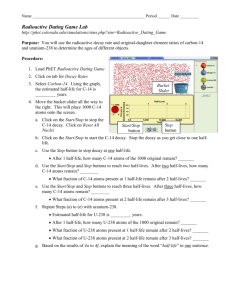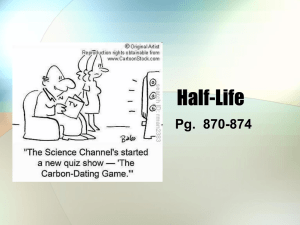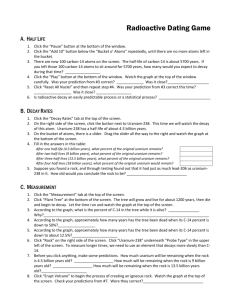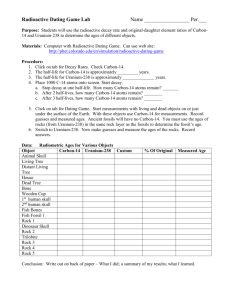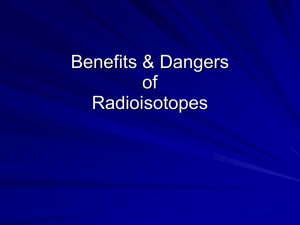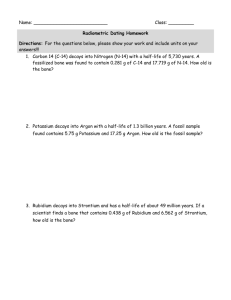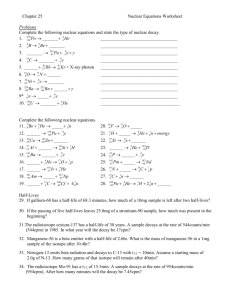Radioactive Dating Lab: Carbon-14 & Uranium-238
advertisement
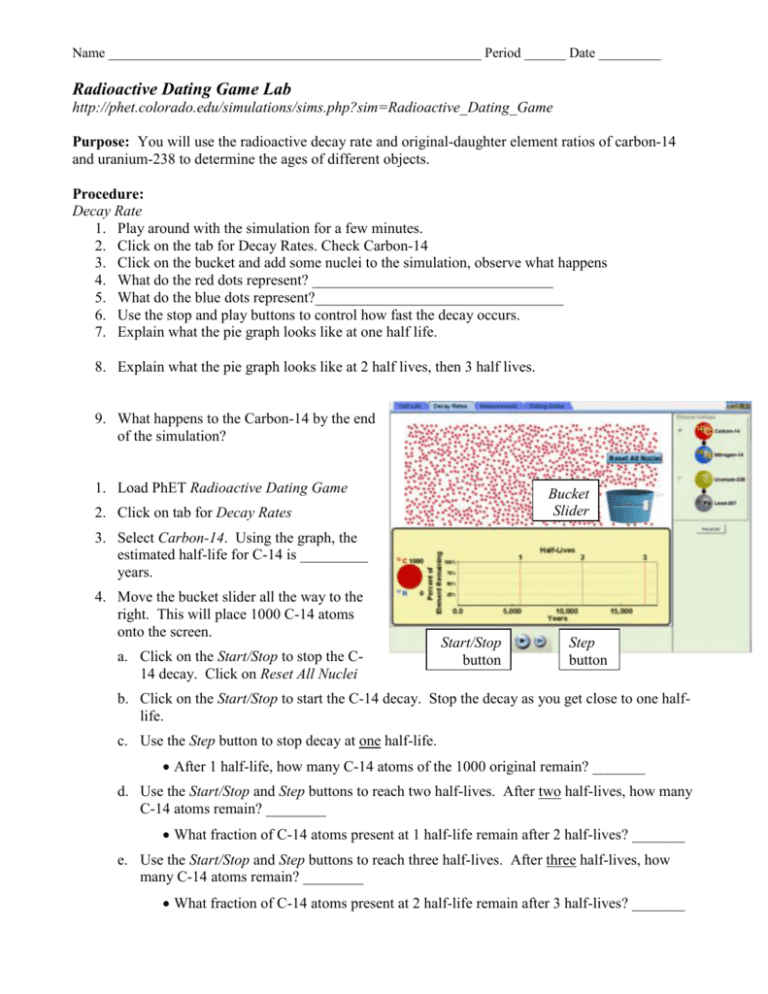
Name ______________________________________________________ Period ______ Date _________ Radioactive Dating Game Lab http://phet.colorado.edu/simulations/sims.php?sim=Radioactive_Dating_Game Purpose: You will use the radioactive decay rate and original-daughter element ratios of carbon-14 and uranium-238 to determine the ages of different objects. Procedure: Decay Rate 1. Play around with the simulation for a few minutes. 2. Click on the tab for Decay Rates. Check Carbon-14 3. Click on the bucket and add some nuclei to the simulation, observe what happens 4. What do the red dots represent? ________________________________ 5. What do the blue dots represent?_________________________________ 6. Use the stop and play buttons to control how fast the decay occurs. 7. Explain what the pie graph looks like at one half life. 8. Explain what the pie graph looks like at 2 half lives, then 3 half lives. 9. What happens to the Carbon-14 by the end of the simulation? 1. Load PhET Radioactive Dating Game Bucket Slider 2. Click on tab for Decay Rates 3. Select Carbon-14. Using the graph, the estimated half-life for C-14 is _________ years. 4. Move the bucket slider all the way to the right. This will place 1000 C-14 atoms onto the screen. a. Click on the Start/Stop to stop the C14 decay. Click on Reset All Nuclei Start/Stop button Step button b. Click on the Start/Stop to start the C-14 decay. Stop the decay as you get close to one halflife. c. Use the Step button to stop decay at one half-life. After 1 half-life, how many C-14 atoms of the 1000 original remain? _______ d. Use the Start/Stop and Step buttons to reach two half-lives. After two half-lives, how many C-14 atoms remain? ________ What fraction of C-14 atoms present at 1 half-life remain after 2 half-lives? _______ e. Use the Start/Stop and Step buttons to reach three half-lives. After three half-lives, how many C-14 atoms remain? ________ What fraction of C-14 atoms present at 2 half-life remain after 3 half-lives? _______ f. Repeat Steps (a) to (e) with uranium-238. Estimated half-life for U-238 is _________ years. After 1 half-life, how many U-238 atoms of the 1000 original remain? _______ What fraction of U-238 atoms present at 1 half-life remain after 2 half-lives? _______ What fraction of U-238 atoms present at 2 half-life remain after 3 half-lives? _______ g. Based on the results of 4a to 4f, explain the meaning of the word “half-life” in one sentence. 5. Click on the Measurement tab. 6. Under Probe Type, select Uranium-238 and Objects. Under Choose an Object, select Rock. 7. Click on Erupt Volcano. Let the simulation run until you reach 1 half-life. What % of the original uranium remains? _________. How many years did this take? ____________ 8. Under Probe Type, select Carbon-14 and Objects. Under Choose an Object, select Tree. 9. Click on Plant Tree. Let the simulation run until you reach 1 half-life. What % of the original carbon remains? _________. How many years did this take? ____________ 10. Explain why uranium-238 is used to measure the age of rocks while carbon-14 is used to measure the age of the tree trunk? 11. Click on Dating Game tab. There are objects on the surface and in the five layers beneath the surface. There are both rocks and fossils in each layer. 12. Select the Carbon-14 detector. Move the Geiger counter to each fossil and record the % of original in the table below 13. On the ½ life graph, move the green arrow right or left until the % of original matches the reading on the detector. Record your estimated age for each fossil in the table 14. Repeat Steps 12 and 13 using the Uranium2-38 detector to estimate the rock ages. For fossils with no remaining C-14 signal, use the rock ages to estimate fossil ages in the same layer. 15. Summarize how C-14 and U-238 dating together can be used to determine fossil ages. Table: Radiometric Ages for Various Objects Object Animal Skull Living Tree Distant Living Tree House Dead Tree Bone Wooden Cup 1st human skull 2nd human skull Fish Bones Fish Fossil 1 Rock 1 Dinosaur Skull Rock 2 Trilobite Rock 3 Rock 4 Rock 5 Measured using C-14 or U-238? % of Original Guessed Age Measured Age

